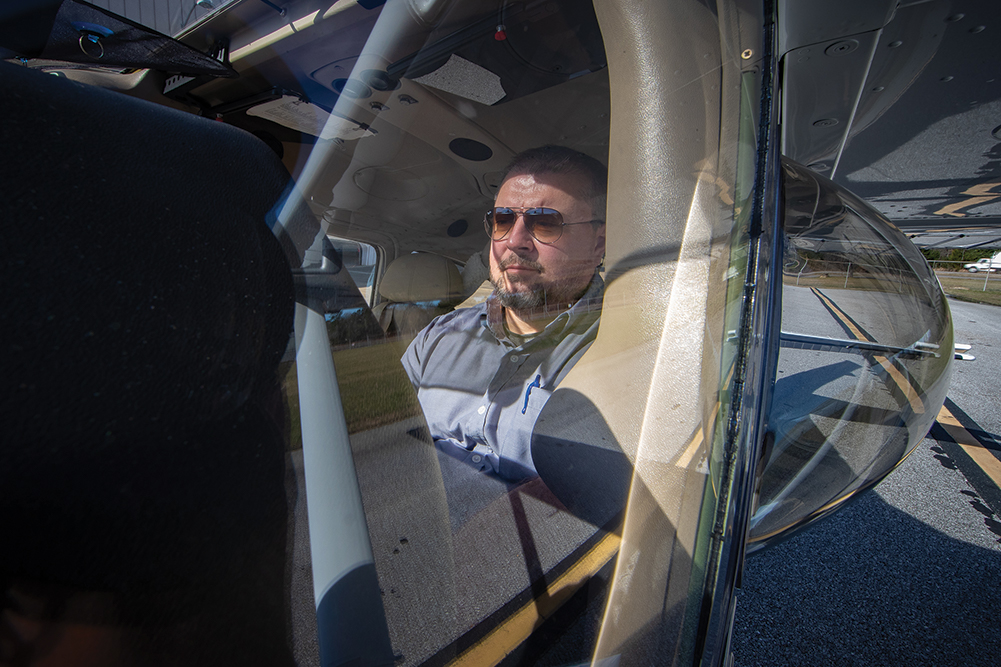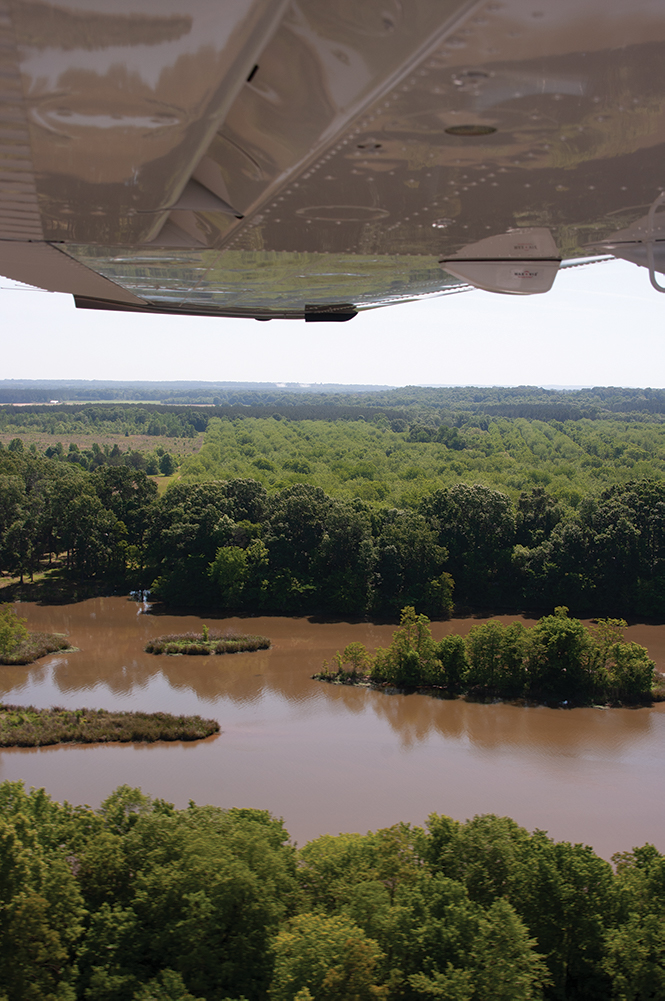By Allison Law
William Johnston does his pre-flight check of the single-engine Cessna 182, the plane he flies for the Wildlife and Freshwater Fisheries (WFF) Division in the Alabama Department of Conservation and Natural Resources (ADCNR). His mission today: to check for populations of cattle egrets, do a visual check of an active eagle’s nest, and give some visitors a glimpse of what is for him another day at the office, providing the eyes in the skies for the state of Alabama.
When Johnston flies, he’s always accompanied – either by a wildlife biologist, when he’s needed to help with surveys of deer, turkey or other animals, or a conservation officer, when he’s flying for law en- forcement purposes. During hunting season, the missions are almost always related to enforcement, look- ing for illegal bait and night hunting.

“It’s amazing what you can see from the air,” Johnston says. “There’s no hiding from us.” The aviation program is a critical component of Alabama’s conservation efforts. With eagles, for example, at one time there were few in the state; the Conservation Department got involved with eagle restoration, and Johnston’s flights allow biologists to monitor their nesting activities and provide a way to document the program’s success in restoring the majestic birds to Alabama.
Johnston is also involved in the state’s annual waterfowl survey. He’ll fly down to the delta area in south Alabama, all the way up to the Tennessee River area to monitor the counts of certain species of water birds, which has to be done at certain times of the year.
Marine Resources – another division within the Conservation Department uses the plane to count crab traps inside the bay near Mobile. A task that takes several days by boat, Johnston can help personnel accomplish in a matter of hours.
He can attach antennae to the airplane that will track animals deer, turkey and bats, among others that biologists have outfitted with radio transmitters. Such surveys help the Conservation Department to manage, protect and enhance the populations of all of Alabama’s wildlife, some of which are endangered or imperiled.
Challenges
The airplane Johnston flies is equipped with up-to-date avionics and high-tech flight displays and communications capabilities. It also has an enhanced vision system called MaxViz, which presents real-time images of the external en- vironment and allows for safe flying at night.
“One of the things that scares me most is hitting wildlife on takeoff and landing,” Johnston says. “Those are the most dangerous parts of fly- ing.”
Yet another hazard, thanks to technology: drones.
“In the past, we just worried about a bird strike,” says Fred Harders, as- sistant director of the WFF division. But drones are metal, not flesh and bone, and have the potential to do real damage to aircraft – and the personnel on the plane.

General aviation cannot fly below 500 feet above the ground, and drones are limited to 400 feet above the ground. But a 100-foot separation is a small comfort. “We don’t fly over populated areas, but we do fly over parks,
places where people like to take drones,” Johnston says. “So we have to change our missions based on the use of technology.”
While drones are potential hazard, they have the ability to pro- vide imagery from above – which is a part of Johnston’s job. But he doesn’t think they’ll replace what he can do.
“A lot of people think drones are something you see on TV. You sit in your chair and play video games,” he says. But by regulation, the drone has to be in the line of sight of the pilot.
And accessibility is another hindrance that Johnston doesn’t have. To see a beaver dam, for example, Johnston can fly right over it; a drone operator would have to get close to the dam, per- haps into swampy, inaccessible areas, to launch a drone.
Professional drones can cost from the tens of thousands to millions of dollars – not nearly as economical as an airplane and a pilot, who acts as a shared resource between divisions and even among different agencies.
Still, some might consider a high-tech airplane as a luxury item, an extravagance in times of tight state budgets. Not so, Harders says.
For law enforcement, they fly both day and night; to pay for a private pilot and airplane would be cost-prohibitive. And Johnston can be called on for other kinds of flights: he recently flew some state Department of Transportation personnel around the Birmingham area to gauge traffic flow. And he can be called at a moment’s notice after a severe weather event or some other kind of disaster.
After the BP oil spill, he was part of the response from day one, flying people and supplies, for aerial surveillance and imagery.
“Having an aircraft is not a luxury, it’s a work item,” Harders says. And for the record, the ADCNR receives no General Fund support; its funding is generated through special revenues, including user and license fees.
Skill in the skies
Johnston was born in Brazil, to a Brazilian mother and an American engineer father. He lived all over – South America, Washington, D.C., San Francisco – and after high school joined the U.S. Army. He was an engineer on active duty from 1990 – 1994 with a deployment to Iraq.
He started taking flying lessons in 1995, and his first job was flying banners up and down the beach in south Florida. For better pay, he moved to Alaska and earned his instructor’s license; he built hours and started flying cargo on a turbo prop.
“It’s unique, Alaska,” Johnston says, recalling the extreme weather, treacherous terrain and rough, rugged airstrips. He had an experience there that would change his career path.
It was a dangerous flying scenario, but he wasn’t scared. “I realized that I’m so used to that kind of flying, I’m going to kill myself because I didn’t get scared,” he says. The danger wasn’t lack of skill; it was that he had grown too accustomed to risk.
“I’m too comfortable flying this kind of stuff.”
He applied with the state of Alabama and started flying for the Department of Environmental Management (ADEM) in 2004. He moved over to ADCNR seven years ago.
He flies about 250 hours in an average year; he has 9,600 hours of flight time total and has a rating to fly three large airplanes, including the Citation CJ4, which the governor uses. In fact, he flew Gov. Kay Ivey when she was lieutenant governor.
Today, he enjoys being a part of the state’s efforts to promote conservation and wildlife law enforcement. “I love flying, but I’m accomplishing something.”
Harders says Johnston’s flying is not just from airport to airport. “It’s a highly skilled, technical flying that he does in that aircraft,” Harders says, noting that it’s important for ADCNR to have a pilot of his skill level.
Johnston knows that other types of flying – for an airline, for example – offer good money, and carry a certain prestige. But shuttling people from point A to point B doesn’t provide the sense of accomplishment he enjoys now. “I really enjoy looking back and saying, I was a part of that.”





